This easy baklava recipe is a beloved Greek dessert you can make in your own kitchen! Delicate, flaky sheets of phyllo dough are layered with a crunchy walnut-and-cinnamon filling, and then soaked in a sweet honey syrup.
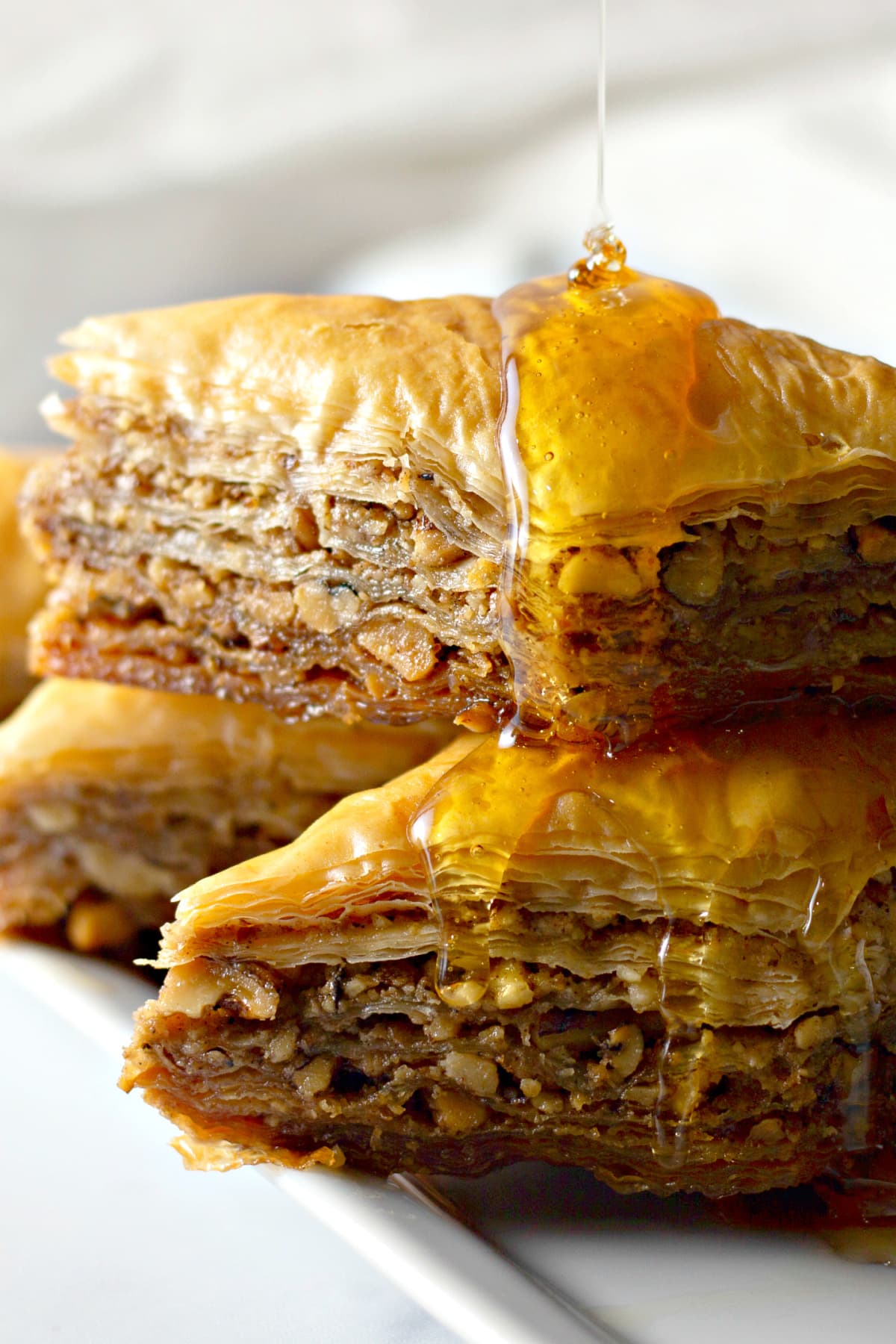
The Best Baklava Recipe
If you love store-bought baklava, get ready for a revelation – because as good as the store-bought kind is, it’s no match for homemade baklava.
If you’ve never tried making your own baklava before, you might feel a little bit intimidated. All of those delicate layers, the golden sticky syrup, and the crunchy nut topping are so unlike a typical cake or cookie bake, right? But don’t let that stop you! It’s actually easy to make homemade baklava using store-bought phyllo.
That’s right, the pastry for baklava comes ready-made! Even professional bakers rarely make phyllo dough in-house. So there’s no shame in our phyllo game! And once you have the dough, all you have to do is brush it lightly with melted butter, one sheet at a time, and layer it with an easy cinnamon-nut filling mixture. It’s really kind of fun! So grab your pastry brush, turn on some good music, and let’s make baklava!
Why You’ll Love this Baklava Recipe
- Easy. Homemade baklava comes together in a snap with store-bought phyllo and a few other simple ingredients.
- Impressive. Despite how easy it is to make, everyone is going to be so impressed that you made baklava from scratch!
- Flavorful. This Greek baklava recipe is totally delicious with all the buttery layers of dough, nutty layers, and honey syrup.
- Can be made ahead. This dessert can seriously be made ahead – as much as 1 week in advance. All of the honey keeps it fresh for a long time. You can even freeze it for up to 3 months.
Where Does Baklava Come From?
Believe it or not, this is a question that has caused many, many debates. You can find desserts similar to baklava going back all the way to ancient Greece. The Roman Empire, Hungary, Turkey, and other Middle Eastern countries also have versions of baklava that date back centuries.
There are some differences though. For example, Turkish Baklava tends to use pistachios, whereas Greek Baklava usually uses walnuts. This baklava recipe is Greek in origin.

Baklava Recipe Ingredients
Here’s what you’ll need to make classic baklava. For ideas on how to customize this recipe, check out the “Variations” section. And to see the complete recipe card with amounts, nutrition facts, and full recipe instructions, scroll down to the bottom of this post.
- Phyllo Dough: You’ll find this in the freezer section of your grocery store, usually alongside the frozen pie crust and puff pastry.
- Honey: Use your favorite honey—any kind will do!
- Water: To thin the syrup to the correct consistency.
- Granulated Sugar: Along with the honey, the sugar adds sweetness, and it also boils down with the water to help create the candy-like syrup.
- Fresh Lemon Juice: For this recipe, it’s best to juice fresh lemons for the brightest lemon flavor.
- Walnuts: You’ll want to chop or process the walnuts to a chunky consistency, that’s not too coarse or too fine.
- Unsalted Butter: For brushing between the sheets of phyllo dough. That gives the baklava a flaky texture!
Are Phyllo Dough and Puff Pastry the Same?
Phyllo dough and puff pastry are definitely similar in some ways, but they are not the same! Puff pastry is flaky and buttery, but ultimately it’s also bready: think crescent roll dough. While I’m sure it would make a tasty dessert paired with cinnamon, nuts, and honey syrup (hmmm, note to self: must try that sometime), it won’t be baklava.
Phyllo, on the other hand, doesn’t have a bready texture at all! Each sheet is paper-thin, and when layered with melted butter, those paper-thin sheets of dough turn into crackly, delicate layers that have a perfectly satisfying crunch.
How to Make Baklava from Scratch
To make the baklava, it’s all about building the layers one by one, and then baking until done. From there, you’ll pour the syrup evenly over the whole thing, and let it rest so that the syrup is absorbed by the baklava. Easy!
- Prep the Oven and Filling. Preheat your oven to 325ºF degrees. Then, combine the finely chopped walnuts and cinnamon in a medium bowl and set aside.
- Make the Syrup. Combine the sugar, water, honey, and lemon juice in a saucepan, and bring it to boil a over medium-high heat, stirring often, until the sugar is dissolved. Once that happens, reduce the heat to low, and let the syrup simmer (this time without stirring) for exactly four minutes. Now the syrup is done! Turn the heat off, and set the syrup aside to cool down while we “build” the baklava.
- Prep the Baking Dish and Phyllo Pastry. Grease a 13 x 9-inch glass baking dish with 1 tablespoon of the melted butter. Open the phyllo pastry dough package. If it looks like your phyllo sheets are too large for your pan, you can cut the whole stack to fit, using a sharp knife or kitchen shears. Cover the phyllo sheets with a damp tea towel or paper towel, so that they don’t dry out while you’re working with them.
Layering Baklava
- Make the First Layer. Lay one sheet of the phyllo dough into the bottom of the buttered dish. Gently brush with a thin layer of melted butter. Repeat this with nine more sheets of phyllo, to make a stack of 10 sheets with melted butter in between. Evenly sprinkle about 3/4 cup of the chopped nut mixture over the top of the stack.
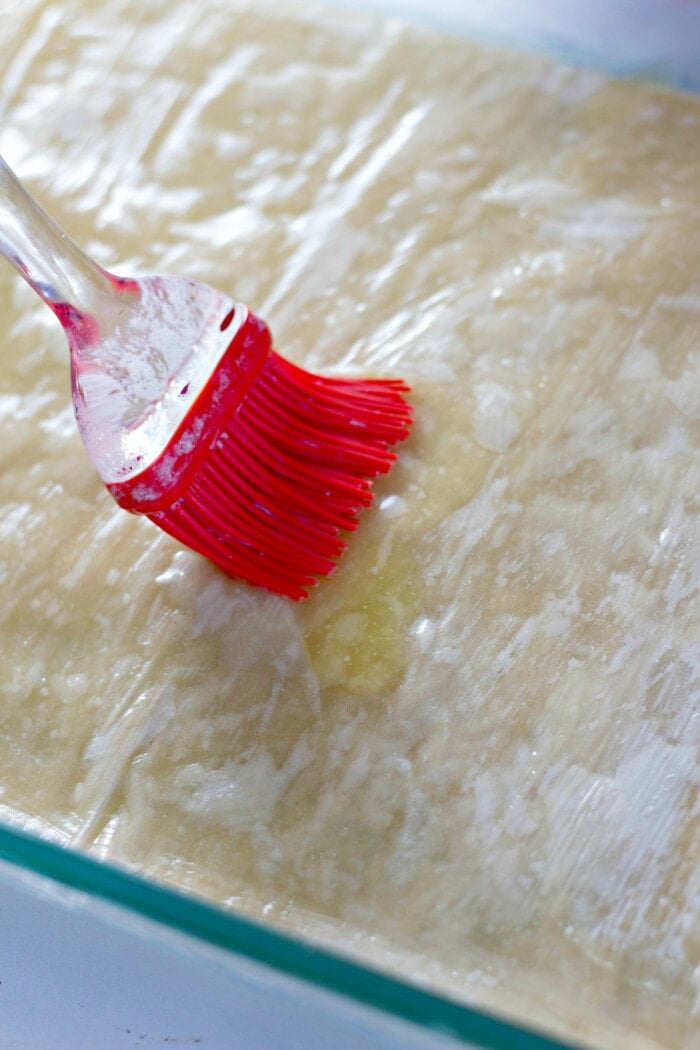
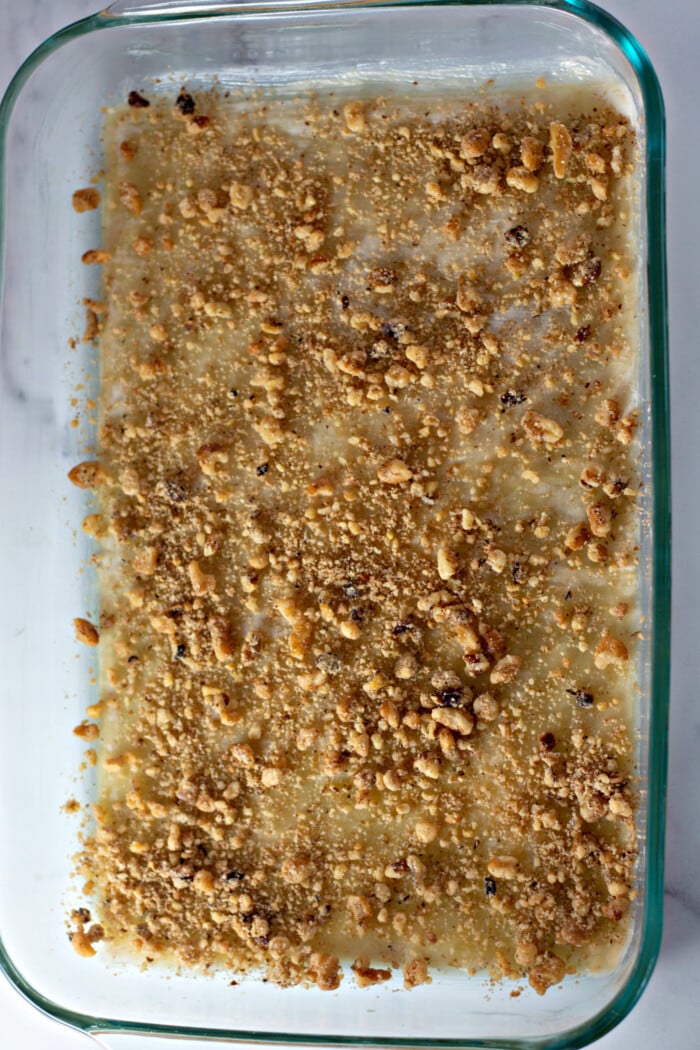
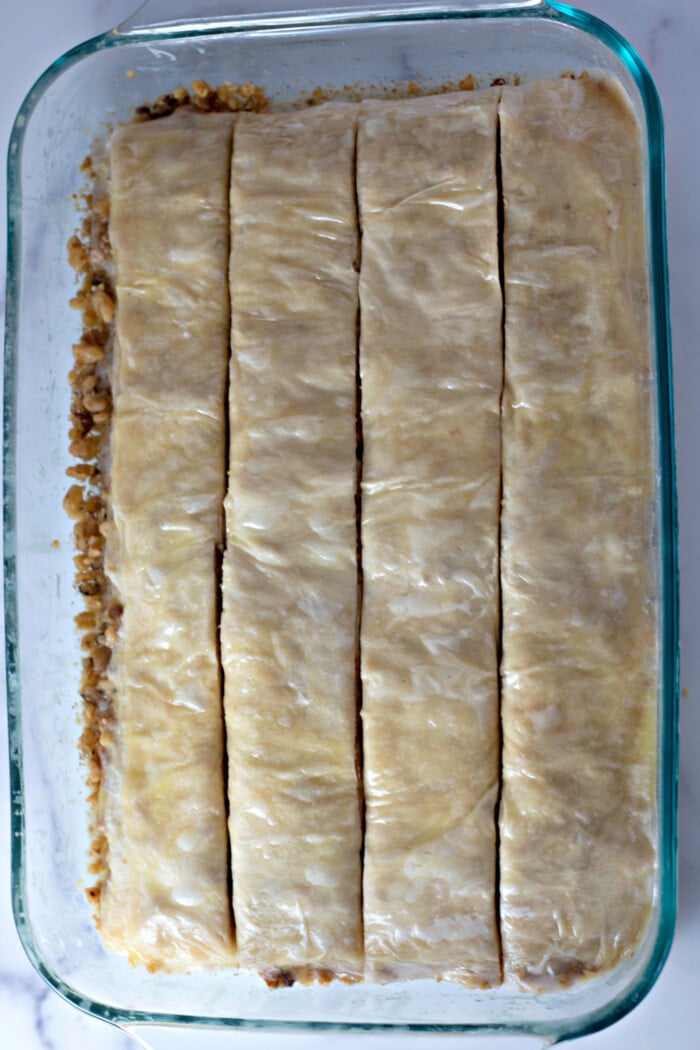
- Make the Remaining Layers. Lay a stack of 5 sheets of phyllo dough over the walnut mixture, brushing each sheet with a small amount of butter as you go. Sprinkle another ¾ cup of the walnut mixture over the stack. Repeat the layers of 5 buttered phyllo sheets and 3/4 cup of topping, until walnut mixture is used up. Then top the whole thing with 10 last sheets of phyllo dough, brushing butter on each as you add them.
- Cut and Bake. Brush the last layer with butter, and then slice the baklava into one-and-a-half inch strips across, then diagonally. You should have classic diamond-shaped baklava. Bake this uncovered for an hour and 25 minutes or so, until the pastry is golden-brown.
- Add the Syrup, and Rest the Baklava. After the baklava has baked, take it out of the oven, and pour the syrup over it slowly and gently, trying to get an even pour over the entire dish. Most of the syrup will run down to the bottom, which is what it is supposed to do! But some of it will trickle into the top layers as well. You’ll end up with a lightly sweet and crispy top, with a sweeter and more dense bottom layer. Let the baklava cool completely (and ideally rest overnight) before serving.
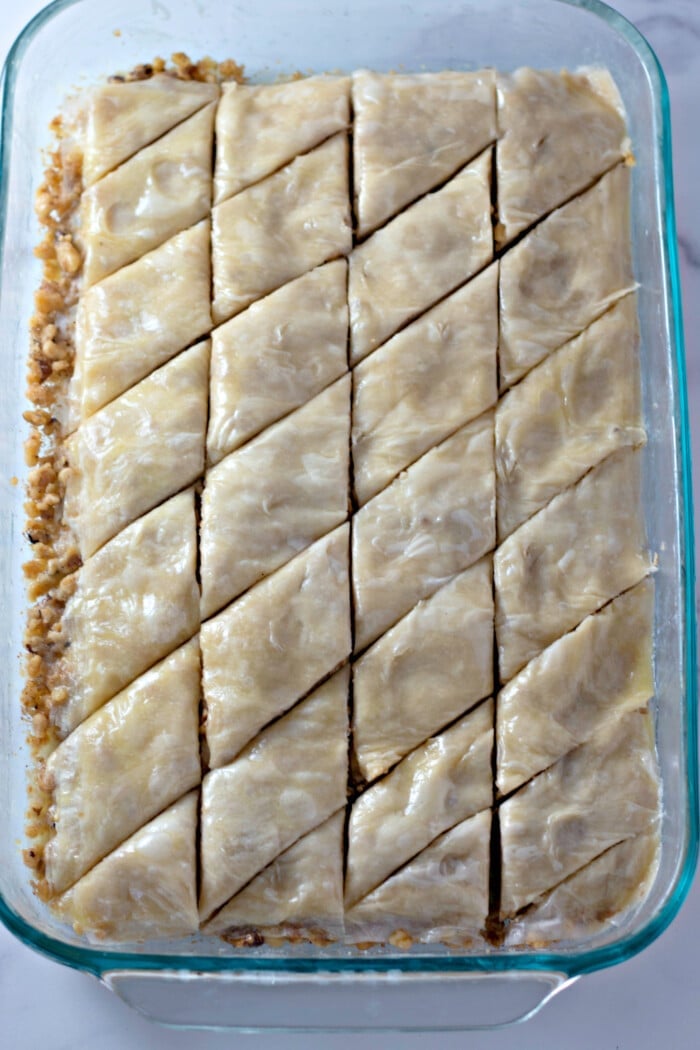
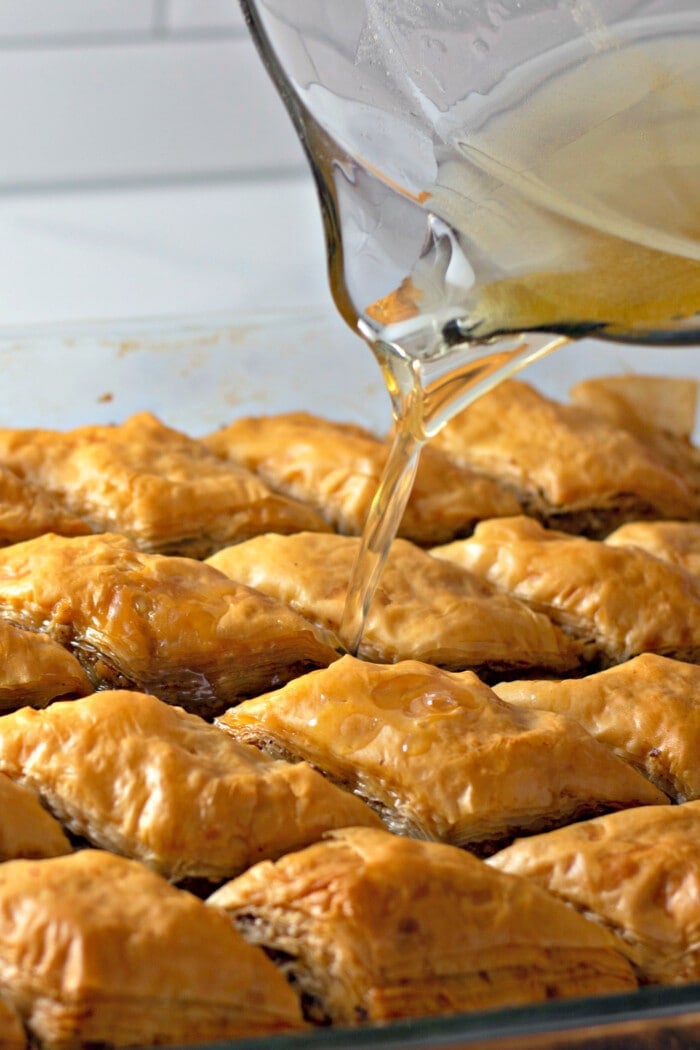
Tips for Success
Everyone has their favorite tips and tricks for making the perfect batch of baklava! Here are some of my favorite helpful hints for making this dessert with ease.
- Thaw Carefully: The phyllo pastry must be thawed before you use it—frozen phyllo will crack and break apart while you handle it! Usually, phyllo is thawed overnight in the refrigerator, but some cooks recommend keeping it frozen until you’re ready to use it, and then microwaving for 30 to 60 seconds.
- Keep Damp: You don’t want to wet the dough, because it’s so thin it will dissolve! At the same time, don’t let it dry out, because it’s so thin it will crumble. The best thing is to keep it humid, if that makes sense, by laying a damp (not wet!) towel or paper towel over the top of your phyllo pastry, moving it to grab a new sheet, and replacing it while you butter the sheet.
- Be Patient! Making baklava isn’t difficult, but it does take some time. If you find yourself having to rush, it’s likely that you’ll end up with torn and crumbling sheets of pastry! So try to set aside at least an hour or so to assemble the dish, plus the hour and a half of baking time.

Baklava Recipe Flavor Variations
Since baklava is a traditional sweet in lots of different cultures (Greek, Turkish, Lebanese, Syrian, and Eastern European, just to name a few!) there are tons of different variations out there. Here are some easy variations you can try in your own kitchen!
- Pistachio: Using crushed pistachios instead of crushed walnuts is an easy and authentic swap. Many classic baklava recipes call for using pistachios, with their distinctive green color and salty-sweet flavor. You can also use a combination of pistachios and walnuts.
- Rosewater: Middle Eastern baklava is often scented with rosewater, which adds a beautiful floral taste and fragrance to this honeyed recipe. Just add 1/2 teaspoon (or to taste) to the syrup as it simmers.
- Chocolate: Drizzle your baked and cooled baklava with melted chocolate for a satisfying twist! Just microwave a cup of chocolate chips in a microwave-safe bowl for 5-10 seconds at a time, stirring each time. When the chocolate is melted, stir in a tablespoon of butter, and then drizzle over the baklava with a spoon. Allow to cool before serving.
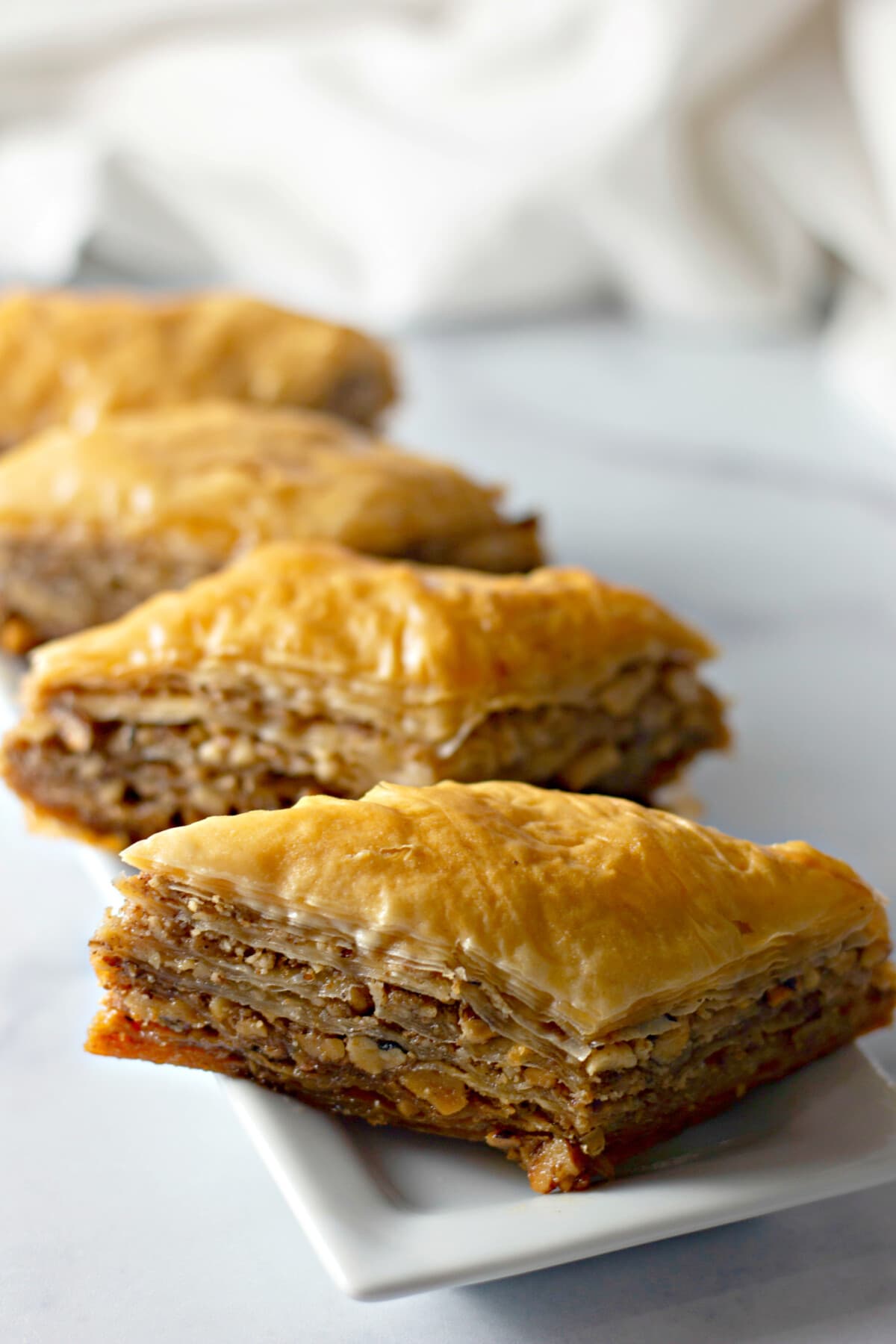
Frequently Asked Questions
Here are some common questions about making baklava from scratch. Have another one to add? Please share in the comments!
Why is my baklava soggy?
Usually, this happens because too much butter was used between each layer of phyllo dough. Bake sure that you only apply a thin layer and that you use a pastry brush to apply it evenly.
Why is my baklava dry?
This can happen when the butter has not been applied evenly to every part of the phyllo. Here again, using a pastry brush is super helpful! Make sure you apply a thin coat to every part of the phyllo, including the edges.
How to Store Homemade Baklava
To store homemade baklava, cover it well with plastic wrap or place it in an airtight container. Baklava will keep its texture best if you store it at room temperature, rather than in the refrigerator. It will stay fresh for up to 1 week.
More Traditional European Desserts
- Lebkuchen (German Spice Cookies)
- Spritz Cookies
- Old-Fashioned Gingerbread Cake
- Christmas Linzer Cookies
- Italian Ricotta Cookies
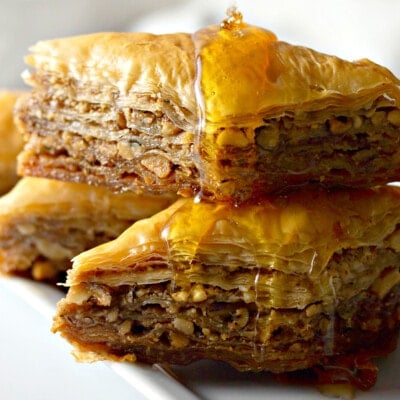
Easy Baklava Recipe
Ingredients
- 1 cup granulated sugar
- 3/4 cup water
- 1/2 cup pure honey
- 2 tablespoons fresh lemon juice
- 16 ounce package phyllo dough thawed
- 1 cup unsalted butter 2-sticks melted
- 4 cups walnuts finely chopped
- 1 tablespoon ground cinnamon
Instructions
- Open the phyllo pastry dough package and cover with a damp towel to prevent drying out. If needed, trim the dough to fit your glass baking dish.
- Grease a 13 x 9-inch or larger glass baking dish with 1 tablespoon of the melted butter and set aside.
- In a medium saucepan, combine the sugar, water, honey, and lemon juice. Bring to a boil over medium-high heat, stirring often until the sugar is dissolved. Reduce the heat to low and simmer without stirring for 4 minutes; set aside to cool.
- Preheat oven to 325F degrees.
- Combine the finely chopped walnuts and cinnamon in a medium bowl.
- Lay 1 sheet of the phyllo dough into the bottom of the buttered dish. Brush with melted butter, then repeat with 9 more sheets of phyllo. Spread ¾ cup of the walnut mixture evenly over the phyllo layer.
- Lay another 5 sheets of phyllo dough over top of the walnut mixture, brushing each with butter. Sprinkle on another ¾ cup of the walnut mixture.
- Repeat until walnut mixture is used up, then top with 10 last sheets of phyllo dough, brushing butter on each as you add them.
- Brush the top layer with butter, then slice the pastry into 1 1/2 inch strips and then slice diagonally in both directions to create diamonds.
- Bake uncovered for 1 hour 25 minutes until pastry is golden brown.
- Immediately after removing from the oven, pour the cooled syrup over the pastry.
- Let cool completely before serving. For best results, let the baklava sit covered overnight to soak up the syrup.


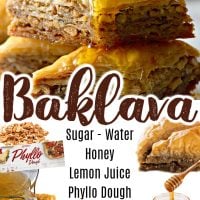
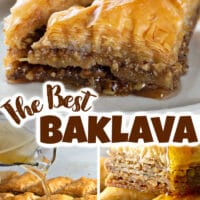
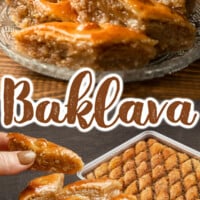
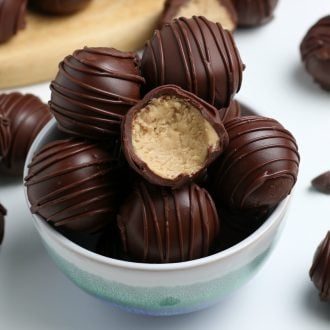
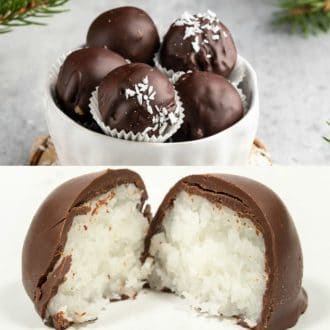

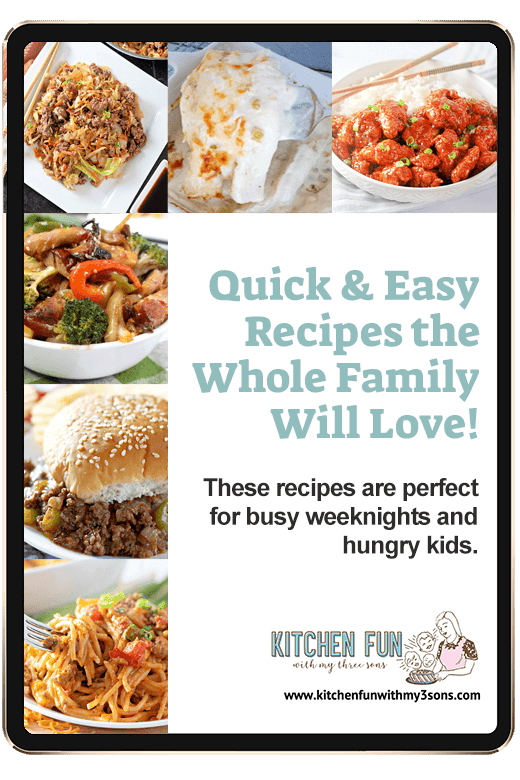
Leave a Review!
We LOVE hearing from you! Submit your question or comment here.
Your email address will not be published.
8 comments on “Greek Baklava Recipe”
I have made this recipe twice. The first time I was nervous about the dough dying out so I followed the recipe exactly covering the dough with a damp cloth. The second time I just threw it together not worrying about the dough drying out both were absolutely delicious definitely recommend this recipe easy and delicious!
Thanks great Cari! Thanks!
Can I use pistachios? Same amount?
Absolutely!
Could I use pecans instead of walnuts?
Rachel, yes you could use pecans.
Have made baklava hundreds of times. Be sure that the syrup is cold and the baklava hot or you will have a soggy mess. Also, put one slice of fresh white bread into the processor when you are grinding, chopping, the nuts. Some people use bread crumbs. This helps keep the nuts in place instead of falling out of the pastry when you eat it. No matter what, it will taste delicious!
Awesome advice and 100% correct. I use breadcrumbs.